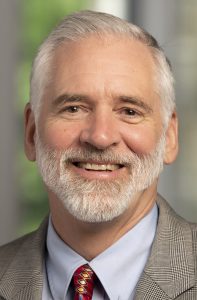In 1850, there were about 700,000 Baptists in the United States, evenly divided between North and South. As the nation expanded and grew, Baptists advanced in membership and social standing. As they expanded, they divided into divergent denominational groups, and as they divided they multiplied.
By 1962, the two oldest Baptist bodies alone numbered almost 12 million — the American (Northern) Baptists with 1.5 million and the Southern Baptists with 10 million.

Curtis Freeman
When Baptists began as a dissenting minority, they were forced to support the established churches and punished by civil authorities when they refused. They overwhelmingly endorsed the secular government of the United States with its constitutional guarantees of a free church, a free state, free speech and a free press. They backed procedural secularity of the Republic because it gave them the freedom to exercise their faith in public without undue interference from civil authorities.
Gardner C. Taylor, pastor of Concord Baptist Church in Brooklyn, N.Y., for more than 40 years and one of the most influential Baptist preachers of the 20th century, said Baptists defend the separation of church and state (borrowing a sports metaphor) because it gives them “swinging room” to practice their faith.
The percentage of Baptists to the total population in the United States went from 16.9% in 1776 to 20.5% in 1850.
In 1850, Baptists made up 30% of the total religious adherents in the South, and by 1926 they comprised 43% of all religious adherents in the South.
In the North, Baptists were 15% of the total religious adherents in 1850, but only 6% by 1926.
The Southern Baptist Convention had 33 members per 1,000 Americans in 1890, and by 1986 that number had risen to 74 members per 1,000 Americans.
Membership in the American Baptist Churches USA peaked in the 1980s with about 1.6 million, and by 2023 it had dropped to just over 1.2 million members. The Southern Baptists reached their high-water mark in 2006, when they reported 16.3 million members. Since then, the numbers fell drastically below 16 million by 2011, below 15 million by 2018, and below 14 million by 2021. The current membership is 13.2 million, which is roughly the same as it was in 1978.
Commenting on the dramatic decrease, Ryan Burge recently observed, “There’s no other way to say this: The decline the SBC is experiencing is at a scope and scale that has not been seen in any other Protestant denomination in American history.”
Their once dominant presence in the South that earned Baptists the status of a de facto established church is fast fading. Secularization and steady disestablishment are in full swing.
“It cannot be the coveted future that desires a return to privilege and power provided by cultural establishment.”
It is past time to envision a future beyond Christendom, but it cannot be the coveted future that desires a return to privilege and power provided by cultural establishment. The church of the future must resist the Constantinian temptation.
Christians no longer live in a world that affirms with confidence, “God is in the midst of the city” (Psalm 46:5). The social location of the post-Christendom church is not analogous to pre-exilic Israel where the temple, the land and the monarchy provided visible confirmation of established religion, but rather is more like that of the Judeans in Babylon, who the prophet Jeremiah directed to “seek the peace of the city” where they were sent into exile, and to pray on its behalf, promising that in its peace they would find their peace (Jeremiah 29:7).
The church of the future must learn to live as exiles, witnessing not by establishment but by example, working and praying for the peace of the city and the flourishing of the land where it has been placed.
The mission of a post-Christendom church in a secular age is simply to be the body of Christ whose faith and practice bear witness to God’s salvation. Such a drastic change would require nothing less than a new reformation, but the political disestablishment of the church and the participation of ordinary people among 16th-century Baptists and other radical groups anticipated the future of a post-Christendom Christianity.
“The mission of a post-Christendom church in a secular age is simply to be the body of Christ whose faith and practice bear witness to God’s salvation.”
Yet just as the Constantinian establishment of Christianity was an early inflection point of secularization, it may also be helpful to examine the ecclesial vision of Augustine of Hippo, which resists the fusion of church and empire in the fifth century.
On August 24, 410, an invading army led by Alaric the Goth sacked Rome. Although the empire did not collapse for another 60 years, the invasion foreshadowed the ending of an age for Roman Christianity. When news of the sack of Rome reached Jerome in Bethlehem, he confessed to being so shocked that he forgot his own name and was unable to speak.
Christians like Jerome, for whom Rome was the embodiment of Christendom, found it impossible to imagine life beyond a Christianized empire. Pagan leaders seized the opportunity to argue that the sack of Rome was the judgment of the old gods for which the Christians were to blame.
Writing from far-off North Africa, Augustine saw what his contemporaries did not. He suggested the Gothic invasion was neither a sign of the coming apocalypse nor the end of the Christian era. Rather, Augustine detected the hand of divine providence in these events.
He envisioned not one saeculum but two. One was temporal, and the other was eternal. Each age had its own city, but within the temporal age the two cities were mingled together like wheat and tares. The city of God exists in the present age, but its citizens live as exiles. It is on pilgrimage in this world, but its citizens journey by faith to another world.
Augustine reminded his readers that like the exiles of Judea, who wept by the waters of Babylon, they too were strangers in a strange land. He challenged them to remember their identity as resident aliens:
Take heed how thou dwellest among them, O people of God, O body of Christ, O high-born band of wanderers (for thy home is not here, but elsewhere), lest when thou lovest them, strivest for their friendship, and fearest to displease such men, Babylon begin to delight thee and thou forget Jerusalem.
Traveling on its homeward journey, the pilgrim city manifests the hidden design of providence and displays the mysterious presence of grace. Unlike Eusebius, who was little more than an apologist for the Constantinian corpus christianum, Augustine was a cautious critic of the Theodosian tempora christiana.
The citizens of the earthly city have forgotten that they, although rebellious, are still creatures of the Living God, but the pilgrim church exists to signify the promised redemption and to sacralize the secular age.
Secularization is neither the work of the devil nor the end of history. It is the time in which we have been appointed to live. Let us then make peace with the secular city, and let us seek and pray for its peace that we might find our peace.
Curtis W. Freeman serves as research professor of theology and Baptist studies and director of the Baptist House of Studies at Duke Divinity School. This article is a shortened version of his piece “From the Secular City to the Secular Nones” in the spring 2021 issue of The American Baptist Quarterly.
Related articles:
The white church isn’t dying; it’s in exile | Opinon by Alan Bean


